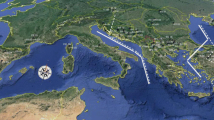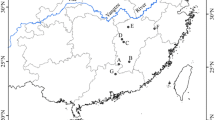Abstract
We analyzed mitochondrial (mt) DNA restriction fragment length polymorphisms (RFLPs) associated with cytochrome oxidase, subunit I (coxI)-related gene sequences in 268 trees derived from 19 natural populations of three species of pines from California (USA): Monterey pine (Pinus radiata D. Don), bishop pine (P. Muricata D. Don), and knobcone pine (P. attenuata Lemm.). Total genomic DNA was digested with four restriction endonucleases and probed with a 750-bp fragment of the mitochondrialcoxI gene amplified fromP. attenuata via the polymerase chain reaction (PCR). ThecoxI gene is repeated at least 4 times in some populations, and all variants that we observed resulted from complex rearrangements rather than from point mutations. There was limited intrapopulation variation, but strong differentiation among populations. When applied to haplotype frequencies, Nei's gene diversity within populations (Hs) averaged 7% (±3), and Gst varied from 75% forP. Radiata to 96% forP. muricata. The high degree of population differentiation for mtDNA suggests that it can be a powerful marker of population differences, but its rapid rate of structural evolution appears to result from recombination among a limited number of repetitive elements-giving frequent homoplasious fragment phenotypes. The phylogenetic trees disagreed with results from chloroplast DNA, nuclear gene, and morphological studies.
Similar content being viewed by others
References
Bendich AJ (1987) Why do chloroplasts and mitochondria have so many copies of their genome? Bioessays 6:279–282
Dong J, Wagner DB (1993) Taxonomic and population differentiation of mitochondrial DNA diversity inPinus banksiana andPinus contorta. Theor Appl Genet (in press)
Glaubitz JC, Carlson JE (1992) RNA editing in the mitochondria of a conifer. Curr Genet 22:163–165
Hong Y-P (1991) Chloroplst DNA variability and phylogeny in the California closed cone pines. PhD thesis, Oregon State University, Corvallis, Ore., USA
Lynch M, Crease TJ (1990) The analysis of population survey data on DNA sequence variation. Mol Biol Evol 7:377–394
Millar CI (1986) The Californian closed cone pines (subsectionOocarpae Little and Critchfield): A taxonomic history and review. Taxon 35:657–670
Millar CI, Strauss SH, Conkle MT, Westfall R (1988) Allozyme differentiation and biosystematics of the Californian closedcone pines. Syst Bot 13:351–370
Mirov NT, Zavarin E, Snajberk K, Costello K (1966) Further studies ofPinus muricata in relation to its taxonomy. Phytochemistry 5:343–355
Palmer JP (1992) Mitochondrial DNA in plant systematics: applications and limitations. In: Soltis PS, Soltis DE, Doyle JJ (eds) Molecular systematics of plants. Chapman & Hall, New York, pp 36–49
Sederoff RR (1987) Molecular mechanisms of mitochondrial genome evolution in higher plants. Am Nat 130:S30-S45
Strauss SH, Doerksen AH (1990) Restriction fragment analysis of pine phylogeny. Evolution 44:1081–1096
Swofford D (1989) BIOSYS-1, Release 1.7. Illinois Natural History Survey, University of Illinois, Champaign, Ill., USA
Wagner DB, Furnier GR, Saghai-Maroof MA, Williams SM, Dancik BP, Allard RW (1987) Chloroplast DNA polymorphisms in lodgepole pine and their hybrids. Proc Natl Acad Sci USA 84:2097–2100
Wagner DB, Dong J, Carlson MR, Yanchuk AD (1991) Paternal leakage of mitochondrial DNA inPinus. Theor Appl Genet 82:510–514
Weir BS (1990) Intraspecific differentiation. In: Hills DM, Moritz C (eds) Molecular systematics. Sinauer Assoc. Sunderland, Mass., pp 373–410
Weir BS, Cockerham CC (1984) Estimating F-statistics for the analysis of population structure. Evolution 38:1358–1370
Whitkus R (1988) Modified version of GENESTAT: a program for computing genetic statistics from allelic frequency data. Plant Genet Newsl 4:10
Wolfe KH, Li W-H, Sharp PM (1987) Rates of nucleotide substitution vary greatly among plant mitochondrial, chloroplast, and nuclear DNAs. Proc Natl Acad Sci USA 84:9054–9058
Author information
Authors and Affiliations
Additional information
Communicated by P. M. A. Tigerstedt
Rights and permissions
About this article
Cite this article
Strauss, S.H., Hong, Y.P. & Hipkins, V.D. High levels of population differentiation for mitochondrial DNA haplotypes inPinus radiata, muricata, andattenuata . Theoret. Appl. Genetics 86, 605–611 (1993). https://doi.org/10.1007/BF00838716
Received:
Accepted:
Issue Date:
DOI: https://doi.org/10.1007/BF00838716




